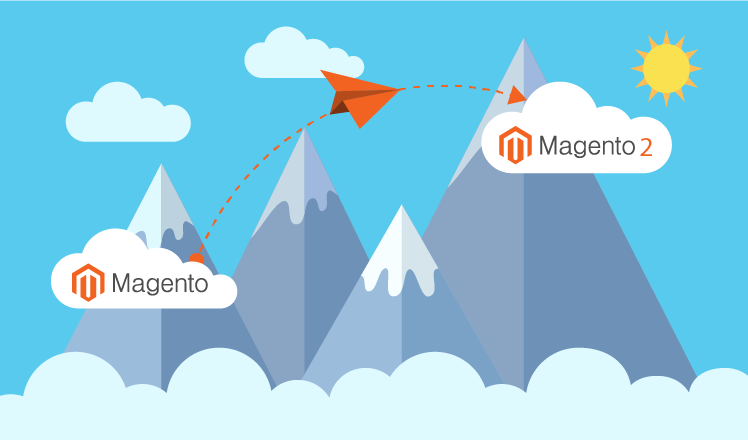Magento 1 to Magento 2 migration guide: when benefits justify the effort
Editor’s note: Almost from the start of the article, you will understand that migration to Magento 2 is a matter of urgency. As far as we provide Magento 2 migration services, Max has briefly mentioned our attitude to migration. Feel free to contact us if you are looking for a team to guide you through the process safely.
Since Magento 2 was released in 2015, the idea of migration has caused much concern among online store owners. Initially, the majority of them didn’t hurry with migration as Magento prolonged the support for Magento 1 for an indefinite time and promised to announce its end-of-life date at least 18 months in advance. However, the Magento representatives were always open about making the primary focus on Magento 2 and packing it with advances with each new release. So, sticking to the first version, retailers fell behind progress – overall, it could affect badly their competitive strength and service level but wasn’t business-critical.

Now, the situation has changed. Magento has officially confirmed the end of support for Magento 1 merchants planned for June 2020. This means that Magento will not provide any quality and security fixes thereafter. The need for Magento 2 migration has automatically transformed from sooner or later to now. If you are still among those on the verge of migration, we’ve prepared a summary of what you should know about this process to survive it successfully. First comes the list of Magento 2 advantages that is to put the matter of migration beyond any doubt.
What’s new or improved in Magento 2
The Magento team adheres to the idea of ongoing platform development. Bearing in mind customers’ high expectations and merchants’ commitment to an ecommerce success, it has complemented Magento 2 with a set of improvements.
Ecommerce businesses benefit from:
- Checkout process. Seeing the importance of not overloading the checkout, Magento 2 makes this process highly customizable. Now, it requires less customer information, contains fewer steps and offers a one-page checkout option – all with the goal of saving customer time and reducing the shopping cart abandonment rate.
- Content management enhancements. In the latest releases, Magento 2 introduces much-needed improvements to Magento CMS capabilities. An outdated WYSIWYG editor gives way to a convenient drag-and-drop page builder. It doesn’t require any programming skills and allows you to discover certain web design talents.
- Mobile traffic. Even if a website doesn’t have a mobile version, improved search capabilities and a simpler checkout process make it more convenient for mobile users. I also strongly encourage you to look into the opportunity of Magento PWA development available since 2019. An alternative to both mobile and web apps, a PWA delivers exceptional mobile experience: instant loading regardless of the network state, quick access from the home screen (with no need to download an app though) and customer engagement tricks (e.g., push notifications).
- Performance. Focused on the ongoing improvement of customer experience, Magento offers 50% faster loading time in catalog and check out pages.
- Search. ElasticSearch becomes a native feature in Magento. And it is believed to enhance customer experience and have a role in conversion optimization.
Technical improvements include:
- Cloud hosting. Magento offers you all the advantages of cloud computing with its Magento Commerce Cloud product. It provides for stable performance, enhanced security, scalability and rapid development.
- Admin experience. The admin panel is optimized for non-technical users. Now, it’s much easier to navigate and manage the store’s back end. The range of improved features includes optimization for different screen sizes, improved usability, modern flat design, new product creation workflow, new data grids and easy column reordering.
- Extensions. Magento has introduced the coding standards to ensure better quality of Magento 2 extensions.
- Testing. Customers shouldn’t see any website malfunctions. With this in mind, Magento 2 offers a built-in framework to facilitate testing and identify bugs earlier than customers would do.
- Database. In Magento 1, developers, admins and customers used the same database. This often resulted in database overload. Magento 2 has three separate databases – product data, checkout and orders and shares the load between them.
What does Magento 2 migration look like?
There are 4 elements of a Magento solution to be migrated.
Themes migration
Magento 1 themes are not compatible with Magento 2. Depending on the digital experience we are going to build on a migrated website, we have two ways to go: purchase a ready-made theme or create a custom one. As a matter of fact, there is always a possibility to use the default Magento theme Luma, but it’s usually more or less viable for really strict budgets only.
Extensions migration
Just as with themes, we must rethink and update all extensions installed on a Magento 1 website. As Magento 2 comes with extended out-of-the-box functionality, it may turn out that you have to pay for some commercial add-ons no more.
Customizations migration
It’s essential that your migration team provides quality Magento web development services and has sufficient expertise in Magento 1 and 2 alike. They will need to convert custom code to Magento 2, edit manually some of the generated files and introduce new custom-built features if needed.
Data migration
Aiming to protect the data from loss, Magento facilitates the process via Data Migration Tool. Still, media files, storefront design and access control lists need to be migrated manually. You can use a necessity to transfer the data to an upgraded store to clean up and optimize the database.
Data migration duration depends on the database size.
The Magento team shared the experience of Magento database migration with 177K products, 355K orders and 214K customers. The process took approximately 10 minutes for settings migration and 9 hours for data migration.
Magento 2 migration plan
Now, let’s see how these migration components form the Magento 2 migration plan.
- Review a current Magento 1 website for redundant data and unnecessary extensions.
- Set up a Magento 2 website.
- Create a new theme or install a ready-made one.
- Migrate customizations and install upgraded extensions.
- Do the testing.
- If necessary, fix issues and repeat the testing.
- Cease all activities in your Magento 1 admin panel.
- Do bulk data migration.
- Go live with a Magento 2 website.
The time required for the creation of a customized Magento 2 web store with a new theme and extensions depends on how deeply you have customized the business logic in your store and what changes you plan now.
Mistakes to avoid
While the aim of Magento 1 to Magento 2 migration is to enhance a store’s functionality, a reckless approach to this process can do more harm than good. Our clients sometimes share the stories of their less successful migrations, and we’ve summarized the mistakes to avoid.
- Wrong time. Magento 2 migration, no matter how expertly it is addressed, always disrupts the store’s operation. Therefore, it shouldn’t be planned for holiday times or seasonal sales.
- Failure to monitor the highest-revenue pages during migration. While a smooth running of the whole website is important, pages that bring most of the money need the first priority.
- Failure to crawl the website. Crawling is required to see the current URL structure of the website. If it changes during the migration, new URLs must be matched with the old ones via 301 redirect.
- Data loss. Disorderly Magento 2 data migration can cause a mess in product descriptions, title tags and meta descriptions, which will negatively influence website’s position in Google search and decrease the traffic level.
- Unsafe migration. To ensure no data is lost for good, it is necessary to back up databases via external hard drive, cloud storage or Zip Drive during migration.
- Lack of testing. Upon the migration, a Magento 2 store must be checked for any issues.
- Failure to retrain the staff. A store upgraded to the new platform version may experience changes in the workflow. To avoid business problems and technical issues, all employees involved must be briefed on the changes.
The migration best practice – don’t take it as data transfer only
The attitude to Magento 2 migration that we share in ScienceSoft is proactive. We analyze the current solution in terms of the experience provided and suggest possible improvements. Thus, a migration process becomes the first step in your Magento solution evolution. If you need our consultancy on migration or any other Magento-related issue, we are happy to help! Contact our team with a brief outline of your situation, and we’ll get in touch without delay.

